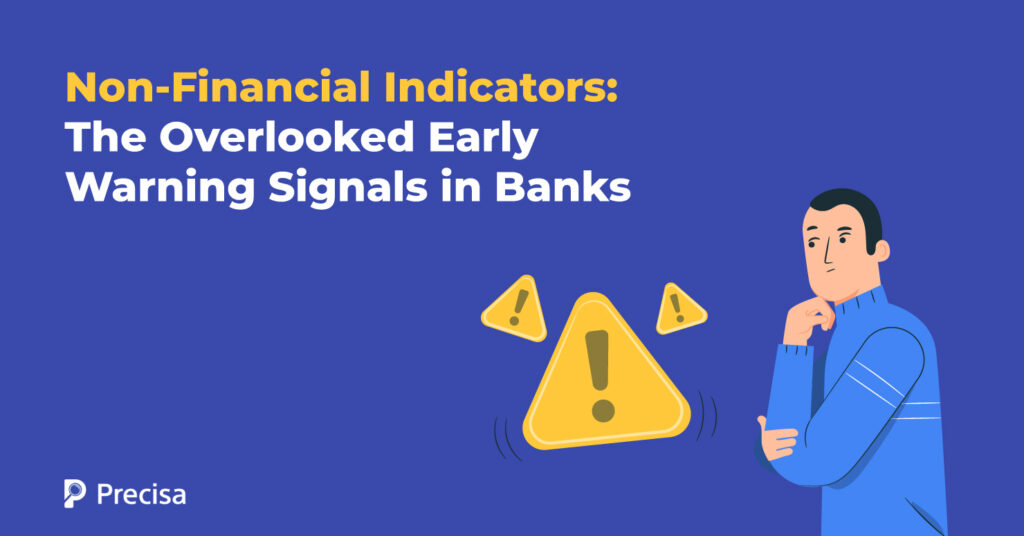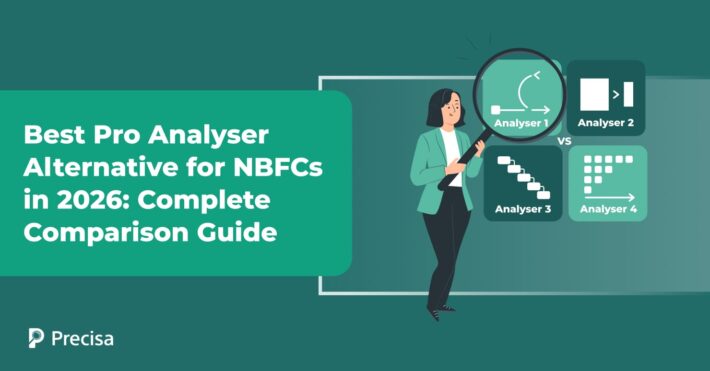Non-Financial Indicators: The Overlooked Early Warning Signals in Banks

A borrower’s financial data provides significant insight into their financial status and creditworthiness. This data helps banks make lending decisions during the underwriting process.
However, it is equally important for banks to observe non-financial indicators that help predict a borrower’s future behaviour. These indicators can inform banks about the ability of a borrower to fulfil loan repayment commitments.
In this blog post, we uncover the early warning signals in banks, and specifically, the non-financial indicators of significance in decision-making.
What are Early Warning Signs in Banks?
Early warning signs in banks refer to early indicators that a potential borrower may default on loan payments in the future. The indicators can be both financial and non-financial in nature.
Financial indicators, for instance, can include various financial ratios such as the debt-to-equity ratio. A borrower’s credit score, and a comprehensive analysis of bank statements, income statements, and balance sheets are also critical financial indicators.
However, non-financial indicators, such as governance issues, environmental factors, social factors, and market trends also play an important role in detecting early warning signs. They include both internal and external factors.
However, many banks often fail to take into account these factors, and the results can be catastrophic.
For instance, banks can experience low liquidity and bankruptcy due to higher loan payment defaults and the growth of Non-performing Assets (NPAs).
Non-Financial Indicators That Show Early Warning Signs in Banks

Here’s a snapshot of key non-financial indicators that offer in-depth insights into the early warning signs in banks.
Borrower’s Past Payment Patterns
A borrower’s past behaviour can offer insight to lenders about their future behaviour. Lenders can observe a borrower’s Equated Monthly Interest (EMI) and credit card payment patterns in their bank statements. Consistently making payments on time and in full, is a positive sign.
On the other hand, consistently defaulting on credit-related payments, making late payments, or only making the minimum payment can be considered negative behaviour. These are the early warning signs in banks.
Late fees and the penalties incurred on various credit products, typically show up on bank statements. By adopting the use of bank statement analysis software, banks can generate detailed reports on credit payment patterns.
Banks can customise dashboards and isolate these payments, and in turn, make data-driven lending decisions.
Industry Forecasts
The success of a business is also dependent upon market forces, and the sustainability of demand for its products and services. Thus besides looking at the financials of a potential borrower, banks must make a thorough study of the industry connected to a business borrower.
Lending teams must be aware of the various market forces impacting the business. The scope of market forces will depend upon the geographical footprint of a business borrower’s customers, clients, and the supply chain.
For instance, say a business has customers overseas, or their supply chain extends to multiple regions around the world. In such a case, lenders must have an understanding of how global market forces can impact the longevity of the business.
These factors will also impact the terms and conditions of the loan such as interest rates, payment tenure, and other aspects. A negative industry forecast can be considered as an early warning sign in banks.
Shifts in Management
Stable senior leadership plays an important role in the long-term success, sustainability, and survival of businesses. It helps nurture customer, client, and investor trust.
On the other hand, sudden shifts in a company’s management can impact the overall functioning of the business.
Such a change can have a domino effect resulting in events such as a mass exodus of employees, a drop in productivity, and layoffs, which can impact revenues and profitability.
These consequences can impact the liquidity of businesses and their ability to pay back a loan on time and in full. Thus management changes can translate to early warning signs in banks.
Major Benefits of Heeding Early Warning Signs in Banks
Paying close attention to the early warning signs in banks can translate into the following:
Reduction of Loan Repayment Defaults
One of the top concerns for banks is the growth of loan defaults and in particular NPAs. Delays in EMI payments, even though they invite penalties, can result in reduced cash flow within the organisation.
Banks need to maintain certain liquidity to ensure optimised operations. Recognising the early warning signs in banks can help teams assess a borrower’s risk profile accurately and reduce payment defaults.
Comprehensive Decision Making
While data from financial indicators help in analysing a borrower’s financial health, data from non-financial indicators is equally important. This is because external factors can also impact a borrower’s ability to repay a loan.
By paying attention to the early warning signs in banks in both categories, lending teams make comprehensive decisions.
Superior Underwriting Capabilities
Gauging the risk factors associated with a borrower, accurately, can help banks customise loan products as per the risk profile of a borrower. They can fix the terms and conditions of the loan in alignment with the borrower’s risk profile. These include aspects such as interest rates, tenure for repayment of the loan, principal amount, and the EMI amount.
Banks can also set a higher collateral requirement if needed, to reduce financial risks.
Superior Curation of Banking Portfolio
Understanding industry trends can help banks make informed decisions as they grow their portfolio. For instance, predicting which sectors are likely to see a higher demand can inform sales teams on which sectors to focus on.
They can make strategic decisions and drive higher conversions as per the forecast. Lenders can take calculated risks, and reap the returns of the long term.
Higher ROI
As banks take a data-driven approach toward reducing loan default payments and the growth of NPAs, they can expect a higher return on investment in banking operations.
They can shift the focus towards improving conversions and delivering customised products that are more relevant to borrower needs. The adoption of an automated bank statement analysis solution can help the banks achieve higher operational efficiency.
The Takeaway
Non-financial indicators related to borrower profiles are playing an increasingly important role in helping lenders make comprehensive data-driven underwriting decisions. By adopting the use of automated financial analysis software, banks can derive more data around these indicators.
In turn, they can gauge and respond appropriately to the early warning signs in banks. Lending teams can allocate the right risk profile to potential borrowers, and work towards optimising revenues and profitability.
Presica’s comprehensive and seamless financial data analysis solution simplifies and speeds up the process through automation. The software provides actionable insights on a customisable dashboard, thus helping companies make informed business decisions.
Request a free demo today!



